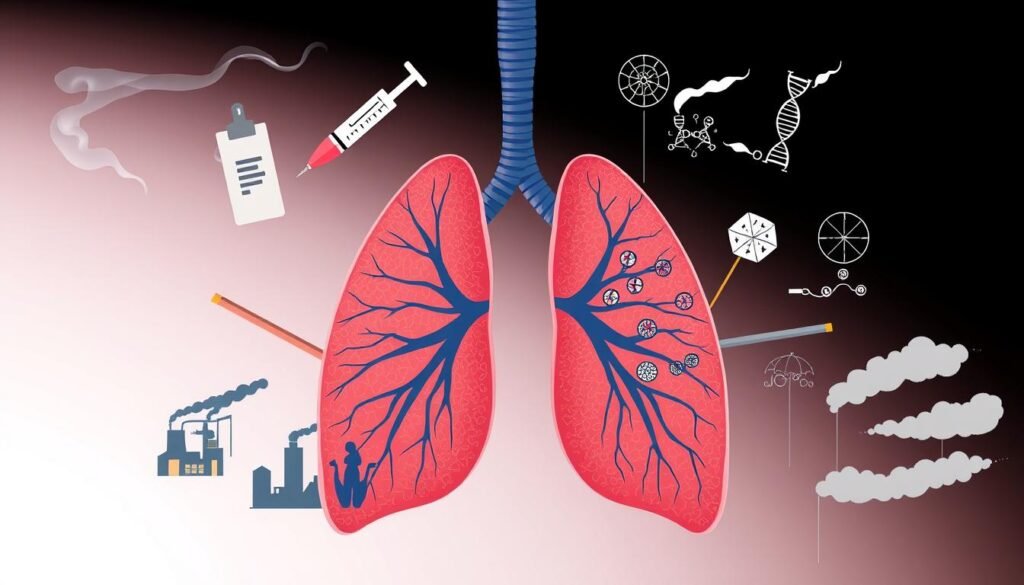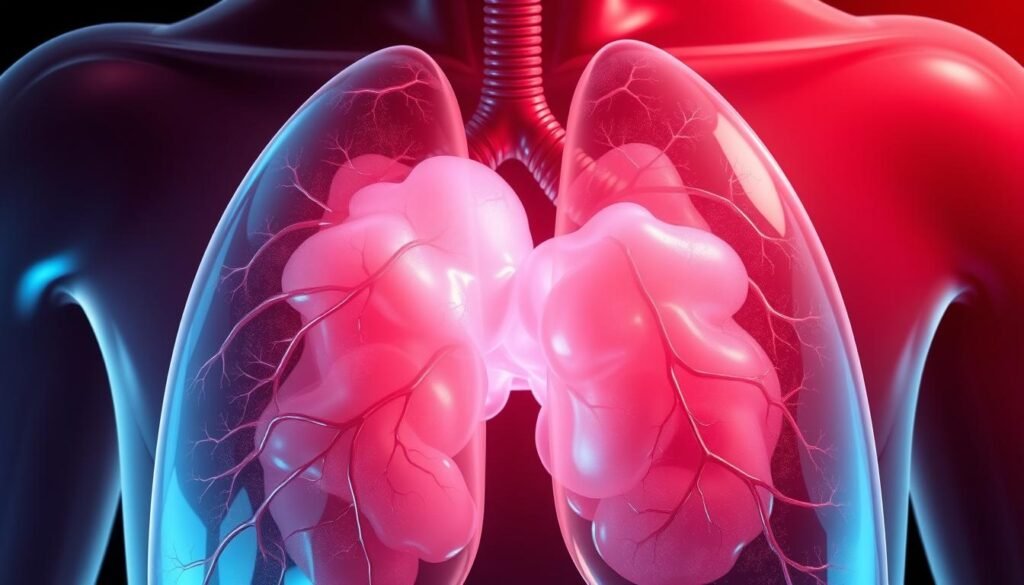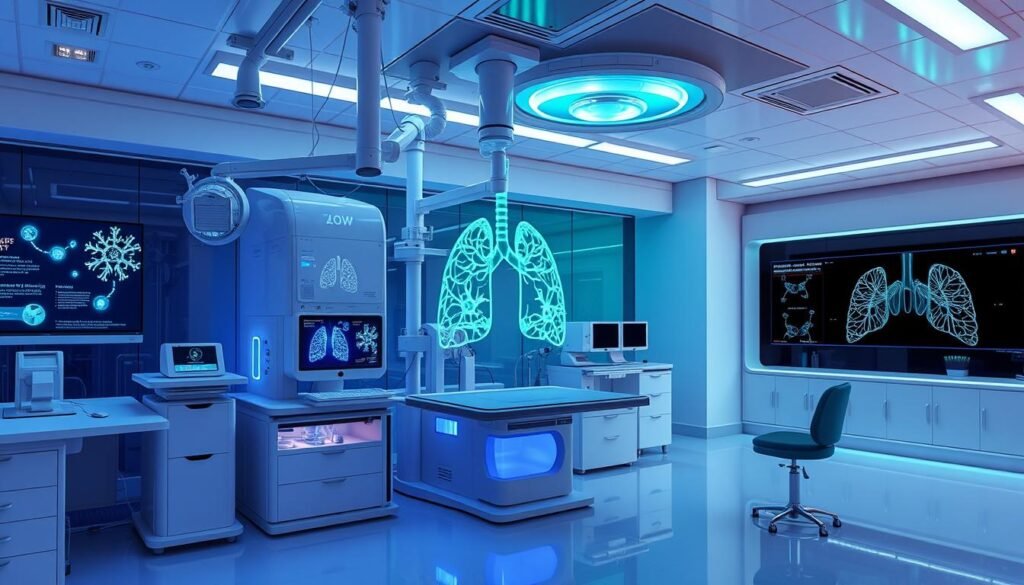About 15% of people with cancer get malignant pleural effusion. This happens when too much fluid builds up around the lungs. It’s mainly tied to lung cancer. Spotting the link between cancer and this excess fluid is key for quick action and handling it right.
We’re looking into cancer affecting lung fluid, covering symptoms, reasons, and treatments. You’ll learn how to notice pleural effusion symptoms and find out about new treatments. This guide focuses on lung cancer’s role in causing malignant pleural effusion. Knowing about this can lead to faster help and better results.
Key Takeaways
- Malignant pleural effusion significantly impacts cancer patients, particularly those with lung cancer.
- Recognizing the symptoms early can lead to more effective treatment options.
- Various techniques are available for diagnosing and managing pleural effusion.
- Indwelling pleural catheters are an effective management strategy for malignant pleural effusion.
- Exploring treatment methods, including chemotherapy and immunotherapy, is essential for optimal patient care.
Understanding Pleural Effusion and Its Relation to Cancer
Pleural effusion happens when too much fluid gathers in the space around the lungs. It’s a serious issue linked to cancer connection. A little fluid is normal and helps the lungs move smoothly. But, too much fluid could point to cancer or other health problems. Recognizing the signs of pleural effusion early can help in treating it, especially when connected to cancer.
What Is Pleural Effusion?
Pleural effusion means there’s more fluid than the body can remove. Malignant pleural effusion (MPE) is especially worrying. It appears when cancer cells enter the pleural area, leading to more fluid. Lung, breast, and lymphoma are typically the cancers behind MPE. Symptoms include:
- Shortness of breath, either at rest or during activity
- Chest pain or pressure
- Coughing
- Fatigue
- Fever
To remove the excess fluid, doctors often perform thoracentesis. It’s a simple procedure done on an outpatient basis, using ultrasound for precision. If the cause of the effusion is still unknown, a thoracoscopy with a biopsy might be done for a clear diagnosis.
The Role of the Pleurae in Lung Health
The pleurae are two layers of tissue that play a key role in protecting the lungs. Cancer can cause these layers to become inflamed, harming their function. Up to 20% of cancer patients might face MPE, which makes treating the original cancer more difficult. The fluid in MPE can contain harmful proteins, creating a bad environment that helps cancer grow.
To learn about early lung cancer signs, check out this link: early warning signs.
Signs and Symptoms of Cancer in Lung Fluid
Finding out the signs of cancer in lung fluid is key. Patients with pleural effusion face discomforts due to fluid in the pleurae. This might point to health issues like cancer. Knowing these symptoms helps catch early warning signs.
Common Symptoms of Pleural Effusion
People with pleural effusion report various symptoms depending on the fluid. Common symptoms include:
- Shortness of breath
- Persistent cough
- Chest pain
- Unexpected weight loss
- Wheezing
- Back pain
- Coughing up blood
- Fever
Spotting these symptoms early can help diagnose problems sooner. This means getting care faster. For more on lung cancer symptoms, visit this resource.
The Importance of Recognizing Early Warning Signs
It’s important to notice early signs of pleural effusion for quick treatment. Symptoms of pleural effusion and cancer often look the same. Ignoring them can delay diagnosis and treatment. This affects recovery. Watching symptoms closely and talking to doctors if there are big changes is advised.
Causes of Cancer in Lung Fluid
Cancer and pleural effusion are closely linked by many factors. Knowing how cancer causes pleural effusion helps us understand this illness. Often, cancer leads to pleural effusion by spreading malignant cells to the pleura. This can cause too much fluid to build up and block the draining paths.
How Cancer Leads to Pleural Effusion
Malignant tumors can cause pleural effusion through several ways. When cancer cells reach the pleura, they might start an inflammation. This increases the production of pleural fluid. Cancer can also block the lymph flow, making the fluid build up worse. This is common in advanced lung cancer, like non-small cell lung cancer (NSCLC). Studies show that 40% to 50% of people with NSCLC get pleural effusion.
Other Conditions That May Cause Fluid Accumulation
Even though cancer is a main reason for pleural effusion, other health issues can also cause fluid buildup. Some of these issues are:
- Heart failure: High pressures in the lung’s blood vessels can push fluid into the pleural space.
- Pneumonia: Lung infections can cause more fluid to be made.
- Kidney disease: When kidneys don’t work right, it can lead to fluid retention, including in the pleura.
- Liver disease: Conditions like cirrhosis can lead to fluid in various parts of the body.
Finding the cause of pleural effusion is key to treating it. An accurate diagnosis means the root problem, from cancer to other issues, gets the right treatment quickly.
Risk Factors for Developing Lung Cancer
Understanding the risk factors for lung cancer is key to preventing it. These factors include lifestyle choices, environment, and where you come from. Knowing and tackling these risks can really make a difference in dealing with lung cancer.
Demographics and Lifestyle Factors
Smoking is the top cause of lung cancer, leading to 90% of cases. But there are other important factors too:
- Having lung cancer in your family doubles your risk.
- Being around smoke, even if you don’t smoke, can still risk your health.
- Working around asbestos can lead to most cases of a cancer called mesothelioma.
- Radon gas is a big risk for lung cancer in non-smokers, causing about 30% of their deaths.
- Taking beta carotene supplements might increase lung cancer risk, especially for people who smoke a lot.
Genetic Predispositions and Environmental Influences
Genetics and the environment also play a big role in lung cancer risk:
- If lung cancer runs in your family, your risk goes up.
- Air pollution and other environmental pollutants also increase the risk.
- Many smokers want to quit, but it’s hard without help.

Diagnosis of Cancer in Lung Fluid
Doctors use many steps to diagnose lung cancer accurately. They look at images and test lab samples. These tests help find pleural effusion, which might mean cancer is present. It’s important to know how these tests work to understand lung cancer diagnosis.
Medical Imaging Techniques
Doctors have many tools to spot pleural effusion and figure out its cause. A chest X-ray can quickly show if there’s fluid buildup. Chest ultrasounds are super accurate, spotting effusion 100% of the time. CT scans and FDG-PET imaging also play a key role in finding malignant effusion. All these methods give doctors a full picture of the patient’s condition.
Cytology and Laboratory Analysis
The cytology exam is key for diagnosing lung cancer, especially with pleural effusion. Thoracentesis collects fluid for testing. This test and others like FNA biopsies and core biopsies are crucial. They help confirm cancer and guide treatment planning. For more on cytology exams, visit this link.
Cancer Types Associated with Pleural Effusion
Malignant pleural effusion is often linked to certain cancers. It’s important to know which cancer types are involved. Lung cancer, especially its two main kinds—non-small cell lung cancer (NSCLC) and small cell lung cancer (SCLC)—plays a big role.
Lung Cancer: Non-Small Cell vs. Small Cell
Lung cancer causes most cases of malignant pleural effusion, making up about 35.6% of them. Non-small cell lung cancer is more common. Small cell lung cancer, on the other hand, spreads quickly. The outlook for people with this issue depends on the cancer’s type and how far it has spread. Tests on the fluid can show if cancer cells are there, helping doctors figure out the type of lung cancer present.
Other Cancers That Can Cause Malignant Pleural Effusion
But lung cancer isn’t the only culprit. Other cancer types can also cause this condition. These include:
- Breast Cancer
- Mesothelioma
- Non-Hodgkin Lymphoma
- Ovarian Cancer
- Stomach Cancer
- Kidney Cancer
- Colon Cancer
- Cancer of Unknown Primary
Breast cancer and mesothelioma are big contributors to malignant pleural effusion, making up 50-65% of cases. Cancer of unknown primary (CUP) is also notable, being hard to identify and linked to 11% of these conditions. Knowing these connections helps in choosing the best treatment and improving patient care.
For more info on malignant pleural effusion and its causes, check out this detailed article on malignant pleural effusions.

Treatment Options for Cancer in Lung Fluid
Treating pleural effusion starts with immediate steps to reduce discomfort. Doctors look at the patient’s health and the effusion’s cause. First, they may remove excess fluid to improve the patient’s quality of life.
Immediate Management of Pleural Effusion
The initial treatment often includes thoracentesis or installing a chest drain. These actions take out fluid from the pleural space. Thoracentesis gives quick symptom relief. Patients can breathe easier and have less chest pain after it.
Below is a detailed comparison of immediate management techniques:
| Procedure | Description | Benefits | Considerations |
|---|---|---|---|
| Thoracentesis | A needle is inserted into the pleural space to remove fluid. | Quick relief of symptoms. | May require follow-up if fluid reaccumulates. |
| Chest Drain Placement | A tube is placed to continuously drain fluid. | Effective for larger fluid volumes or repeated effusions. | Requires hospitalization and monitoring. |
Long-Term Cancer Treatments
After dealing with the fluid, long-term cancer care may include special treatments, chemotherapy, and pleurodesis. Pleurodesis uses sterile talc to make the pleurae stick together, stopping more fluid from building up. This can either be a short visit or a longer hospital stay.
Doctors work with patients to tailor cancer treatment plans. This approach focuses on treating the pleural effusion and the cancer causing it. It aims to make patients live longer and better, even with malignant pleural effusion. This condition’s survival time can vary widely.
Innovations in Thoracic Oncology
There have been great advances in treating lung cancer and related diseases in thoracic oncology. Identifying lung tumor markers is key for diagnosing and treating patients. Thanks to new research, emerging therapies are changing how we tackle malignant pleural effusion, improving patient outcomes.
The Role of Lung Tumor Markers
Lung tumor markers show the presence of lung cancer in the body. They help doctors diagnose lung cancer, figure out its stage, and make personalized treatment plans. By finding specific genetic mutations, lung tumor markers make targeted therapies possible. These therapies attack cancer’s unique traits, improving diagnostic accuracy and managing pleural effusion malignancies.
Emerging Therapies for Malignant Pleural Effusion
New therapies are changing how we treat malignant pleural effusion (MPE). These include targeted therapies against specific cancer cell genes and immunotherapies boosting the immune system’s cancer fight. These new methods promise better survival rates. For MPE patients, there’s now hope in a traditionally tough situation. Multidisciplinary care brings together various treatments, bettering patient experiences and outcomes.

| Type of Therapy | Description | Potential Benefits |
|---|---|---|
| Targeted Therapy | A treatment that uses drugs to target specific genetic mutations within a tumor. | Improved effectiveness and fewer side effects compared to traditional chemotherapy. |
| Immunotherapy | A treatment that helps the immune system recognize and attack cancer cells. | Can lead to long-lasting responses and improved survival rates in certain cancers. |
| Thermal Perfusion Therapy | A technique involving temperature-controlled fluids to disrupt tumor growth. | May improve local control of tumors in the thoracic region. |
Living with Cancer in Lung Fluid
Getting diagnosed with cancer in lung fluid brings tough challenges. It shows the need for all-around care. Such care aims to improve life quality for those being treated. It helps with both physical symptoms and emotional stress.
Supportive Care and Pain Management
For those with lung cancer-related pleural effusion, supportive care is key. Pain control is crucial, managing discomfort from the fluid or the cancer. Many pain relief methods exist, like drugs and nerve blocks. Using physical therapy or relaxation can also make a big difference.
Emotional and Psychological Aspects of Diagnosis
The impact of cancer on emotions is huge. Having emotional support is crucial for patients and families. Being part of support groups or therapy can be very helpful. It allows people to deal with their emotions and connect with others in similar situations. This complete approach helps patients feel stronger during their journey.
Conclusion
Cancer in lung fluid, or pleural effusion, is tough for patients and their doctors. It’s key for patients and families to know about the signs, causes, and treatments. Lung cancer patients often face pleural effusions, making education and awareness crucial.
New tools in diagnostics, like medical thoracoscopy and tumor markers, are improving cancer care. These methods help doctors create better treatment plans by identifying specific cancer markers. Every year in the U.S., there are about 150,000 new cases of malignant pleural effusions. This makes having easy access to information very important.
Research and new treatments are bringing hope to those affected. Emotional support is also critical in managing this disease. Together, medical and emotional support help patients deal with cancer’s effects.